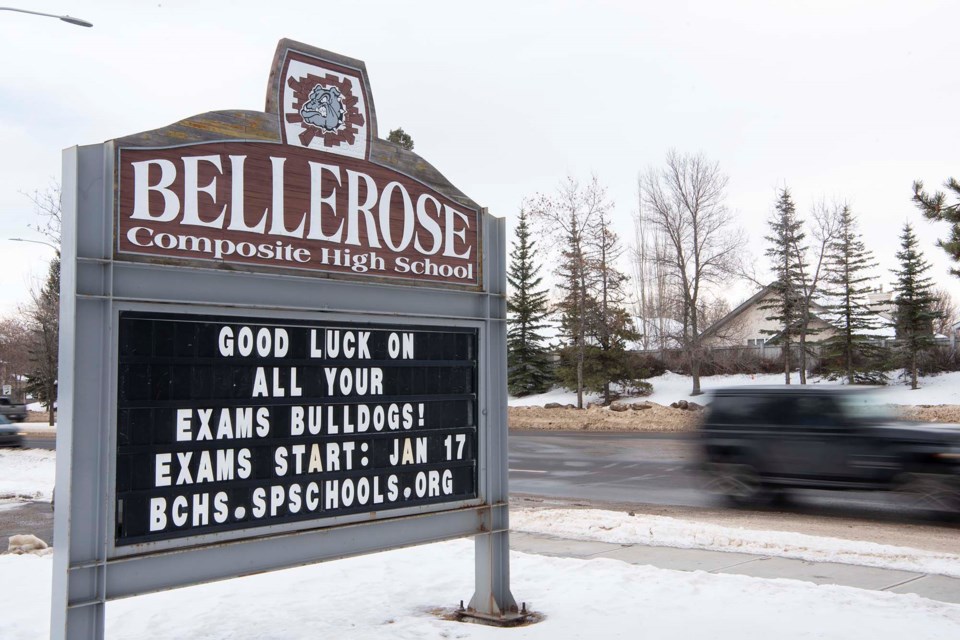What’s in a Name?
The Gazette is looking at the history behind the names of places in St. Albert in light of the city’s move to rename the Grandin neighbourhood. Curious about a place’s name? Send it in to [email protected] so it can be examined in a future story.
Bellerose Composite students might think their school is named after longtime St. Albert area resident Robert Bellerose, whose portrait is in the school’s front lobby.
This is partially correct, in that the school was named after the Bellerose family as a whole following a contest in 1986, noted Musée Héritage Museum archivist Vino Vipulanantharajah. The Bellerose clan has been a part of St. Albert almost since this community was formed, and has several landmarks named in its honour, including Bellerose Drive and Olivier Close.
The first Bellerose
Olivier Bellerose was the first Bellerose to come to St. Albert, historian Dorothy Chartrand, his great-granddaughter, wrote in Black Robe’s Vision. Chartrand described Olivier as “a diligent worker, a trustworthy employee and a stern father” who spent much of his life working for the Hudson’s Bay Company — a gig that saw him trade an astounding 6,000 rats during the winter of 1882. He wasn’t a huge man, standing just five feet five inches tall, but presumably had exceptional stamina from rowing canoes everywhere.
Originally from Quebec, Olivier came to St. Albert sometime in the 1860s and settled on River Lot 35, which Vipulanantharajah said covered what is now the east edge of Erin Ridge and part of Oakmont.
Olivier was part of the nine-person committee that wrote up St. Albert’s first bylaws in 1870, which covered (among other crimes) murder, theft, and driving a sleigh without bells on it. He and his wife with his wife Josephte Savard had 13 children. They and their descendants would eventually own 2,000 acres in St. Albert along both sides of the Sturgeon.
Octave’s school
St. Albert residents later named Olivier Close after Olivier Bellerose, reports A History of Street Names in St. Albert. That same document says Bellerose Drive is now thought to be a reference to Octave Bellerose, son of Olivier.
St. Albert council records and the Gazette’s archives suggest this may not have always been the case. Bellerose Drive was originally an unnamed road. In February 1967, 30 residents who lived on that road asked town council to give it a name to make it easier for them to give people directions to their homes. Council drafted a bill to name this road “Olivier Bellerose Drive” after the Bellerose family, but decided in September 1967 to instead dub it “Bellerose Drive.”
Vipulanantharajah said it’s not clear when people started associating Bellerose Drive with Octave in particular, as he wasn’t explicitly named as the road’s namesake in the town’s minutes.
“It’s safe to say that Bellerose Drive refers to the family,” he said, and that Octave was probably the most well-known member.
Octave Bellerose was born at the Lesser Slave Lake Post in 1849 and came to St. Albert with his family after Father Lacombe established St. Albert, wrote Chartrand, his granddaughter. He was a trapper, hunter, fisherman, logger, interpreter, guide, and farmer, and spoke English, French, and Cree, often mixing the three languages together. He married Lucie L’Hirondelle in 1872 and lived most of his life on River Lot 38 north and east of River Lot 56.
Chartrand described Octave as “a fairly big man” at five feet 11 inches tall and 200 pounds who often wore wool clothes and moccasins while out hauling freight during the winter.
Octave was one of the many area Métis to join the St. Albert Mounted Rifles in 1885. In 896, he was elected president of a local Métis organization that lobbied the federal government to issue land script to Métis children born between 1870 and 1885.
Octave is perhaps best known for his contributions to education in St. Albert.
In January 1885, Octave, Alfred Arcand, and Severe Villeneuve spearheaded the creation of the Bellerose Roman Catholic Public School District, Chartrand wrote. Arcand (namesake of Arcand Drive) initially taught students in his home until the Bellerose School building opened in 1886 on Octave’s land.
The original Bellerose School was one of the first purpose-built schools in Alberta, Vipulanantharajah said. It was an approximately 10-metre by five-metre log structure with two windows, a side door, a wood or coal stove, and a four-acre “playground.” The school moved to another building on the south side of the Sturgeon in 1900 following a flood.
Students at the Bellerose School would have primarily learned about reading, writing, math, grammar, geography and drawing, with Grades 1 to 6 all working in the same room, said Kira Vanzella, public interpretation co-ordinator at Fort Edmonton Park. Attendance would have been irregular, as student were often called away to help on the farms.
“Paper was something very hard to come by,” Vanzella said, so students would have done their work with slates and chalk. There were no desks or chairs initially, with students instead sitting on benches, chairs, and stumps.
The Bellerose School district was folded into what is now Sturgeon Public in 1939, Black Robe’s Vision reports. The original Bellerose School building now resides in Fort Edmonton Park.
Today, a sketch of the first Bellerose School hangs next to Robert Bellerose’s portrait at Bellerose Composite — a reminder of the deep roots of the school’s name.




